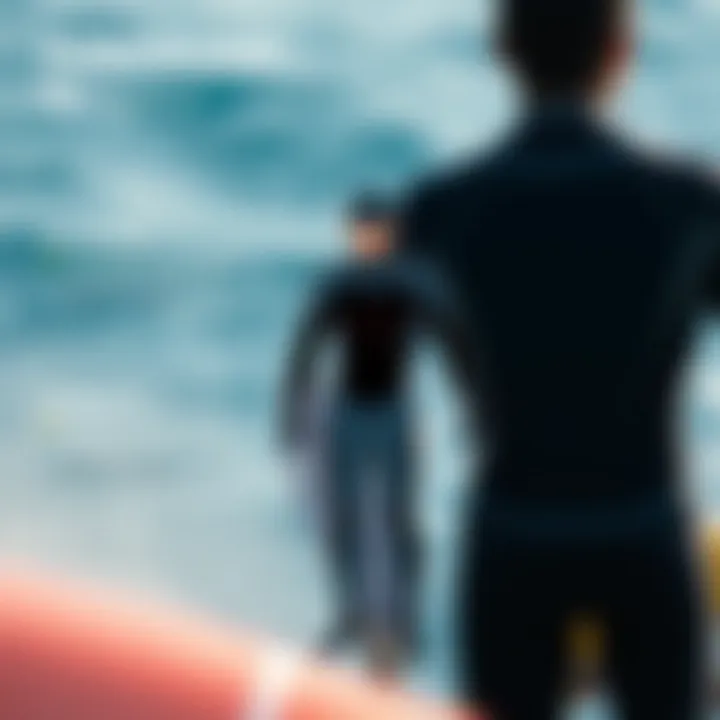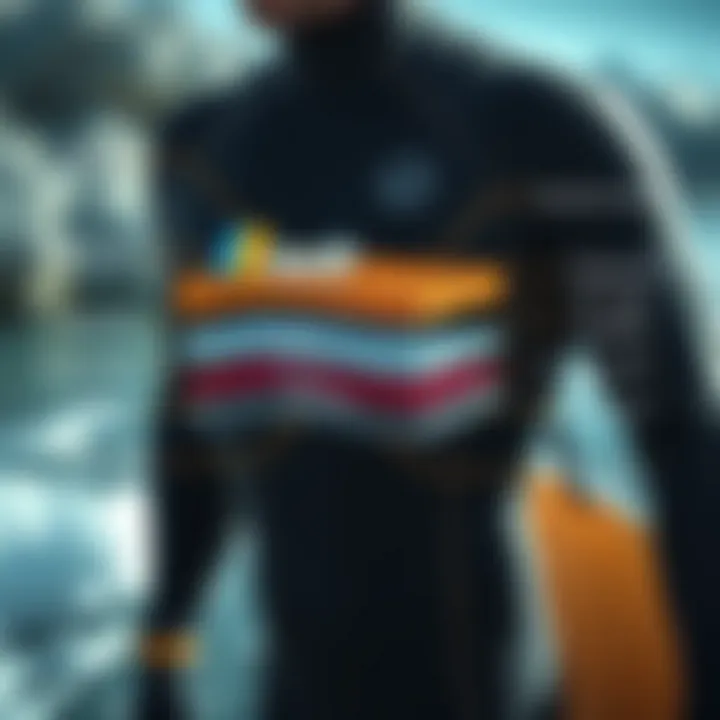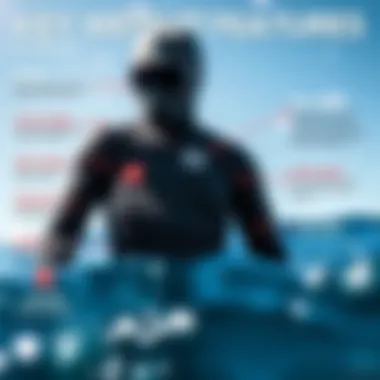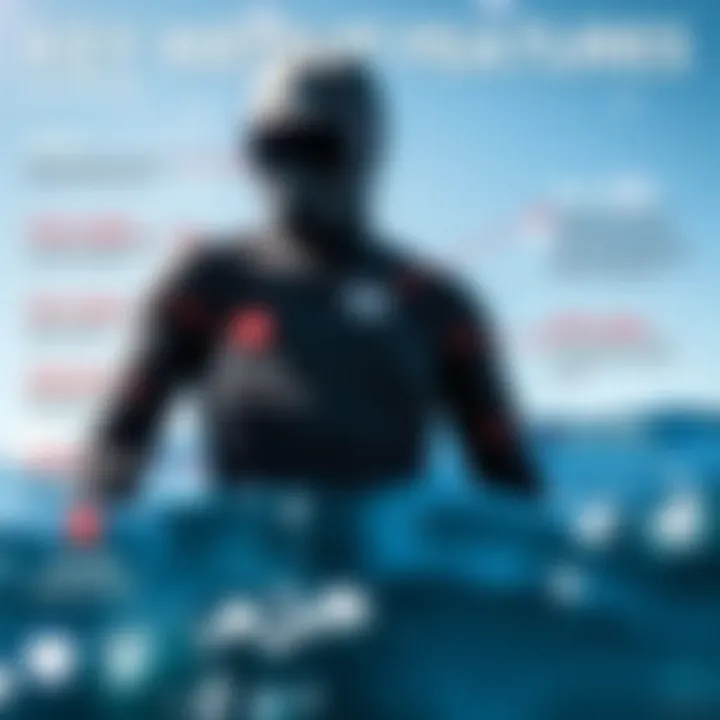Selecting the Best Wetsuit for 60 Degree Water


Intro
When it comes to kiteboarding, the right gear can make all the difference—especially when the water temperature takes a dip to around 60°F. Many novice and experienced kiteboarders often find themselves at a loss when trying to figure out what wetsuit will keep them warm and comfortable without limiting their mobility. A wetsuit that fits well and provides adequate insulation can lead to a better overall experience on the water. However, there are also common misunderstandings about wetsuit functionality that need to be addressed.
Understanding the various factors that influence wetsuit selection is crucial. This article aims to streamline the choosing process by outlining essential attributes such as insulation, material, and fit—each playing a key role in not just performance but also safety. This guide will provide valuable insights for kiteboarding enthusiasts contemplating a purchase, whether they are just starting their adventures or are seasoned pros.
Keywords
In this article, you will come across key terms such as "insulation," "fit," and "material selection" as we delve into each aspect of wetsuit selection. You’ll discover how to take these factors into account when choosing your gear, as well as tips on maintenance for prolonged use. Not to forget, we will also tackle myths that circulate regarding wetsuit use in cooler waters—these misconceptions can affect how effectively one enjoys the kiteboarding experience.
By the end of the article, readers will be equipped with the knowledge needed to select a wetsuit that meets their specific needs while also enhancing their kiteboarding exploits.
Understanding Water Temperature and Its Impact
When kiteboarding or engaging in any water sports, understanding water temperature is crucial for both safety and performance. With temperatures hovering around 60°F, the right wetsuit can make or break your experience, especially if you plan to spend extended periods on the water. Choosing a wetsuit that accommodates the particular chill of such waters involves a thoughtful consideration of thermal insulation, material composition, and the fit of the suit. These factors not only influence your comfort but also your body's capacity to maintain warmth and agility while in the water.
The Science of Water Temperature
Water temperature profoundly affects the body’s thermal regulation. The scientific principle here lies in heat transfer; water is over 25 times more efficient at absorbing body heat than air. So, in a 60°F environment, you can find yourself feeling quite uncomfortably cool if not adequately protected.
The general recommendation suggests dressing for water temperatures around this degree involves thicker neoprene and, often, additional insulation. Understanding how your body interacts with this temperature helps inform your decision-making process. For instance, prolonged exposure can lead to hypothermia, even if you still feel relatively warm.
Key Factors in Understanding Temperature:
- Direct Exposure: Waves and wind often exacerbate the cold, necessitating higher insulation.
- Activity Level: An active ride can heat your body up compared to relaxed floating or waiting.
- Duration of Exposure: Longer sessions call for added insulation to counteract heat loss effectively.
Effects on the Human Body
The human body responds distinctly to cooler waters, especially at the 60-degree mark. When submerged, your body begins losing heat rapidly, influencing physical and cognitive functions. Notably, the shivering response kicks in as your body's innate reaction to cold and serves as a warning that you're at risk of losing too much heat.
Couple that with the adrenaline of kiteboarding, and you might overlook the initial chill. However, prolonged exposure without adequate insulation can impair judgment, leading to compromised safety.
Risks to Keep in Mind:
- Hypothermia: Can set in faster than you’d expect, especially while submerged.
- Muscular Function: Cold can hinder your reflexes and strength, which can be a real setback while engaging in an extreme sport.
- Fatigue: The body will tire itself out just trying to maintain a stable temperature.
"Choosing the right wetsuit isn’t just about comfort; it’s about preserving performance and staying safe in cooler waters."
In summation, comprehending water temperature’s impact is crucial for optimizing your kiteboarding experience. It brings multifaceted insights into how to best prepare for that exhilarating ride on 60°F water. With knowledge in hand, you are better equipped to make informed choices about wetsuit materials, thickness, and overall gear—vital steps toward ensuring not just enjoyment, but also safety on the water.
Wetsuit Basics
Understanding the basics of wetsuits is crucial when gearing up for any water activities, especially in 60 degree water. The right wetsuit not only offers insulation but also enhances performance in cooler conditions. It’s like having the right tool for the job; a well-fitted wetsuit allows kiteboarders to fully enjoy their time on the water without the discomfort of cold temperatures. Moreover, knowing the basics can help you avoid the pitfall of buying a subpar wetsuit that just won’t keep the chill at bay.
What Is a Wetsuit?
A wetsuit is a specialized piece of clothing designed to provide thermal insulation while surfing, diving, or kiteboarding. Usually made from neoprene, it traps a thin layer of water between the suit and your skin. This water gets warmed by your body heat, keeping you relatively cozy in cooler waters.
Think of it as a second skin that protects against both the cold and any nasty scrapes you might encounter while enjoying your favorite water sports.
Types of Wetsuits
When it comes to suits, there’s not just one trick up the sleeve. Different types of wetsuits cater to various conditions and activities. Choosing the right type could mean the difference between a blissful day on the water or a chilly slog back to shore. Here’s an overview:
Full Suits
Full suits cover your entire body, including arms and legs. They tend to be a popular choice because they provide excellent insulation. In 60 degree waters, a full suit can help maintain body heat throughout your session, allowing you to spend more time on the water without feeling like your teeth are chattering.
One of the standout features of full suits is their thermal lining, which maximizes warmth while also wicking away moisture. While they can be a bit cumbersome when temperatures rise, the protection they offer in cooler conditions makes them a go-to for many enthusiast.
Semi-Dry Suits
Semi-dry suits bridge the gap between wetsuits and dry suits. They do a fantastic job of sealing in warmth while still allowing some water exchange, which can be rebuffed with body heat. This characteristic makes them a suitable option for moderate temperatures, such as 60 degrees.
Their key feature is the tighter seal at the neck and cuffs, which helps minimize water entry. However, some wearers might find them a bit tricky to put on or take off, especially if the seals are particularly snug. Overall, they can be a great choice for those who want to balance insulation and flexibility.
Shorties
Shorties, or short-sleeve wetsuits, are designed with shorter legs and sleeves, making them an appealing choice for warmer waters. While they’re generally not ideal for 60 degree temperatures, there are instances when a shorty can suffice, especially on particularly sunny days or if you run hot.
The standout feature of shorties is their freedom of movement, allowing great flexibility while kiteboarding. However, if the temperature drops or winds kick up, you may find yourself wishing for more coverage. So, keep that in mind when considering your options.
Choosing the right wetsuit is a blend of personal preference, activity level, and environmental factors. Understanding the various types can significantly inform your decision-making process, ensuring you’re well-prepared for your next adventure.
Insulation and Thermal Properties
When selecting a wetsuit for waters around 60 degrees Fahrenheit, understanding insulation and thermal properties is crucial. A good wetsuit acts almost like a second skin, playing a pivotal role in retaining body heat. The amount of insulation directly correlates with the material used, the thickness of the suit, and how well it fits your body. Let’s delve into these important components that can help you enjoy your time in cooler waters without compromising comfort or performance.
Neoprene Types
Neoprene is the backbone of wetsuit construction. Not all neoprene is created equal; various types offer different levels of insulation, flexibility, and durability. Traditional neoprene is decent for general use, but new advancements like limestone-based and eco-friendly options are quickly gaining traction. These modern materials can provide better thermal insulation and are also more environmentally friendly.
In colder water, you would benefit from a higher percentage of closed-cell neoprene, which traps air and heat, keeping you warmer during extended periods in the chilly water. On the other hand, if you plan to warm up faster after your session, opting for a breathable material may suit your needs, especially if you’re engaging in high-energy activities like kiteboarding.


"The right neoprene type can be a game changer, enhancing both warmth and mobility in cold waters."
Thickness Guidelines
Thickness is another key factor in a wetsuit’s insulation capabilities. Generally, wetsuits come in various thicknesses, commonly ranging from 2mm to 7mm. However, for 60-degree water, a thickness of 3mm is often adequate, while a 4mm suit may be more suitable for those who feel the cold more intensely or plan to stay in the water for longer periods.
3mm vs. 4mm
When weighing the pros and cons of 3mm versus 4mm thickness, the core consideration boils down to warmth versus flexibility. A 3mm wetsuit is typically more flexible, allowing for easier movement and quicker draining if you happen to get splashed. This flexibility can be a significant advantage for kiteboarders who need to perform rapid movements and tricks. However, in terms of warmth retention, a 4mm wetsuit shines, as it offers an extra layer of insulation, which can be beneficial for longer sessions in the water.
Considerations for Different Conditions
It’s pivotal to think about the specific conditions you’ll be facing. If you’re expecting windy, choppy water conditions, a thicker suit may be necessary, even if the air temperature is relatively comfortable. A 4mm suit could help insulate against the wind chill. Alternatively, in sunny, calm waters, a 3mm wetsuit would likely suffice.
Moreover, check for seasonal shifts, as water temperatures can fluctuate significantly. When local weather patterns change, so too should your wetsuit choice. Take into account the duration of your time spent in water and how intense your activity will be. If you plan to be out kiteboarding for several hours, erring on the side of warmth and choosing a thicker wetsuit may aid in preventing early fatigue from the cold.
In summary, insulation and thermal properties of wetsuits come down to the neoprene type and thickness that meet your specific needs for 60-degree water. Miz it all together, and you’ll stay comfortable and agile, ready to tackle the waves with confidence.
Choosing the Right Fit
When it comes to selecting a wetsuit for 60-degree water, getting the right fit is absolute essential. A snug wetsuit provides the necessary insulation to keep you warm, while also allowing flexibility for movement during your kiteboarding activities. The right fit can make or break your experience in the water. If a wetsuit is too big, it can fill with water, causing you to lose heat quickly. On the other hand, if it’s too tight, it could restrict your movements and affect your comfort. In this section, we will highlight the importance of proper sizing and how to measure yourself for a wetsuit.
Importance of Proper Sizing
Proper sizing ensures that your wetsuit performs its job effectively. Think of it like this: a well-fitted wetsuit is like a second skin. It should cling to your body closely but not so tight that you feel constricted. This close fit helps trap a thin layer of water between your skin and the suit, which your body warms up, keeping you cozy during your time on the water. Getting the size wrong can lead to some uncomfortable scenarios — nobody wants to be battling a wetsuit that won’t budge or is constantly trying to escape from the waves.
How to Measure for a Wetsuit
Getting the correct measurements for a wetsuit is not rocket science, but it does require some attention to detail. There are two main areas to focus on: your chest and waist measurements, as well as considering your height and weight.
Chest and Waist Measurements
Chest and waist measurements are crucial because they determine how well your wetsuit will fit around your core, where heat loss is most pronounced. When taking these measurements, ensure that the tape measure is snug but not overly tight — you want it to reflect your natural body shape.
- Key Characteristic: Your chest size, often the largest circumference of your torso, alongside your waist size helps ensure that the suit provides adequate insulation without being too baggy.
- Why It's Beneficial: A wetsuit that fits well around these areas reduces water entry and loss of heat, making it a popular choice among water sports enthusiasts.
- Unique Feature: Paying attention to the gap between your measurements is also important; a difference might require you to choose between sizes or even brands, as sizing can vary significantly.
Height and Weight Considerations
Height and weight are two additional factors that play a significant role in finding the right wetsuit fit. These measurements help determine the overall length and width of the wetsuit. Generally, wearing a wetsuit that is designed for your specific height and weight can greatly enhance your experience in the water.
- Key Characteristic: The height measurement ensures that the suit is long enough to cover your body adequately, while weight measurements help in determining the thickness and buoyancy of the wetsuit.
- Why It's Beneficial: Most wetsuit manufacturers provide sizing charts that match your height and weight to the appropriate size, thus it is usually straightforward for you to find a suit that’ll fit right.
- Unique Feature: One downside is the range of body types; if you fall outside standard sizing charts, finding a valid fit can be a headache, leading to custom solutions that might be on the pricier side.
Choosing the right fit cannot be overstated in importance for an optimal wetsuit experience. It ultimately affects your comfort, performance, and thermal regulation on those crisp water days.
Key Features to Look For
When it comes to selecting the right wetsuit for 60-degree water, understanding the key features becomes crucial. Each feature plays a vital role in overall performance, comfort, and warmth, making informed decisions essential for the best kiteboarding experience.
Seam Construction
Seam construction is one of the most significant aspects contributing to a wetsuit's durability and performance. Not just the holes in the material hold the suit together; these seams can mean the difference between a warm ride and an uncomfortable one.
Wetsuits commonly use three types of seams: flatlock, glued and blind-stitched, and taped seams. Flatlock seams are the most commonly found in cheaper models. They lay flat against the skin but do allow some water to seep in. On the flip side, glued and blind-stitched seams create a tight, waterproof design. They minimize water entry, allowing rider to stay warmer and maintain comfort. Taped seams offer even more durability, combining the strength of glue with an additional layer of tape for enhanced protection. Knowing which seam style is used can affect warmth and the suit's longevity.
Entry Systems
Choosing the right entry system can greatly influence how easy it is to put on and take off the wetsuit, as well as its effectiveness in keeping water out.
Back Zip
The back zip wetsuit is quite popular, especially among novice kiteboarders. Its key characteristic is the zipper running down the back, making it easier to slip into. This entry type tends to be more forgiving when it comes to sizing, so it’s a good choice for folks still figuring out their preferences.
However, while it's simple to don and doff, back zip wetsuits might allow slightly more water seepage compared to other entry styles. This can be a disadvantage in colder waters, as even small amounts of water entering can cool the body down.
Front Zip
Front zip wetsuits take a different approach. This design features a zipper along the front, allowing for a sleek fit and minimizing the chance of water entering. They often feel tighter and less bulky, leading to increased aerodynamics and movement.
That being said, some find these suits trickier to put on. The tightness might be intimidating for new users, yet many experienced riders swear by their performance in keeping warmth. When you want something that stays put while carving through waves, front zips shine.
Chest Zip
The chest zip, a newer innovation, has gained popularity due to its snug, streamlined fit. It essentially combines the best of both worlds: entry is through a zip located on the chest, allowing for easier entry while providing a solid barrier against currents seeping in.
While these suits often provide superior warmth retention, they can also be pricier. For avid kiters looking for increased insulation during their session, a chest zip wetsuit presents a strong argument. However, those who dislike the feeling of confinement may want to try one on before committing.
Lining Materials
The lining material of a wetsuit directly correlates with warmth and comfort. Neoprene is the most common, but not all neoprene is created equal. Different lining materials may offer enhanced insulation or quick-drying properties.
- Thermal Linings: Materials like hollow fiber or special fleece linings provide extra warmth without adding bulk, making them ideal for maintaining body temperature in cool environments.
- Quick-Dry Fabrics: Moisture-wicking fabrics are advantageous for faster drying times. This aspect is not only convenient but helps reduce unwanted odors.
- Eco-Friendly Options: Certain brands are now experimenting with environmentally friendly materials that do not compromise performance. Choosing these can add peace of mind while participating in water sports.
Going for the right lining can significantly improve your experience, particularly when kiteboarding in lower temperatures, where every bit of insulation counts.


Overall, when sifting through the available options, take the time to consider these features. Each individual feature will cater to specific needs and conditions, guiding you toward a wetsuit that truly enhances your time on the water.
Wetsuit Maintenance and Care
Wetsuits are essential gear for kiteboarders, especially in cooler water like the 60°F range. Proper maintenance and care can extend the lifespan of your wetsuit and ensure it performs at its best, making it a crucial topic in this guide. By investing a little effort into cleaning and storage, you not only improve the longevity of your wetsuit but also enhance your overall experience on the water. Neglecting this aspect can lead to serious performance issues and costly replacements.
Cleaning Your Wetsuit
After each use, especially in saltwater or chlorinated environments, it’s essential to clean your wetsuit properly. Here’s a straightforward process to make sure you don’t cut corners:
- Rinse Immediately: As soon as you’re done kiteboarding, rinse your wetsuit with fresh, cool water. This helps to remove salt, sand, and chlorine. Letting those elements sit can cause wear and tear.
- Use Mild Soap: Every now and then, especially after intensive use, gently wash your wetsuit with a wetsuit-specific soap. Avoid harsh detergents, as they can break down the neoprene. Just a small amount will do the trick.
- Avoid the Machine: Never toss your wetsuit in the washing machine. High temperatures and vigorous agitation can destroy the material. A gentle hand wash is the way to go.
- Dry Properly: After rinsing or washing, hang your wetsuit inside out to dry in a shaded area. Direct sunlight can degrade the neoprene over time. Make sure to hang it on a broad hanger to maintain its shape.
Taking those steps can help in keeping your wetsuit fresh and working well, while also ensuring that unpleasant odors don’t become a frequent visitor.
Storage Tips
When it comes to storing your wetsuit, the details matter. Here are some best practices to ensure it remains in good condition during the off-season or between uses:
- Keep it Dark and Cool: Store your wetsuit in a cool, dry place away from direct sunlight. A dark area prevents UV rays from damaging the material.
- Avoid Folding: Rather than folding your wetsuit, hang it on a wide hanger. Folding can create creases that might become permanent and weaken the suit.
- Use Suit Bags: If you have a specific wetsuit bag, use it for extra protection. It can keep the wetsuit clean and also provides a buffer against sharp objects.
- Don’t Let it Sit Wet: Ensure the wetsuit is completely dry before storing it. Keeping it damp can lead to mildew and a world of unpleasant smells.
By taking care of your wetsuit with these cleaning and storage techniques, you’ll ensure it stays snug and in prime condition, ready for your next adventure on the water, just like a trusty companion that’s always there for you.
Addressing Common Myths
Addressing common myths surrounding wetsuits serves a vital role in helping kiteboarders and water sports enthusiasts make informed decisions. Misconceptions can lead to poor choices regarding equipment, which in turn, can affect performance, comfort, and safety in cool water. By debunking these myths, we not only clarify the facts but also empower individuals to choose gear that meets their needs, particularly for those venturing into 60-degree water, which can be quite chilly.
Wetsuits and Body Temperature Control
A misunderstanding often encountered is the notion that wetsuits work like a magical barrier, capable of maintaining body temperature at all costs. In reality, a wetsuit's function is vastly more nuanced. It primarily acts as an insulating layer of neoprene that traps a thin layer of water between the suit and your skin. That layer gets heated by body warmth, which helps in keeping your core temp stable. This means that wearing a wetsuit doesn’t completely stop you from feeling cold. Instead, it provides a temporary shield against the chill.
Interestingly, some claim that thicker wetsuits are always better. This isn’t necessarily true. While a thicker material like 5mm might seem like a good idea for colder waters, it can restrict movement, leading to fatigue. A well-fitted and properly selected wetsuit for the conditions—such as a 4mm suit for 60-degree water—can allow enough flexibility while still managing thermal regulation effectively.
"Selecting the right wetsuit thickness is not just a matter of warmth; it's about maintaining flexibility and comfort too."
Misconceptions About Thickness
Another prevalent myth revolves around the belief that more thickness equals more warmth. While it holds some truth, it’s crucial to consider how thickness interacts with other factors such as layer fit, suit design, and individual body composition. For instance, someone with a higher metabolism may find they retain warmth differently than others. Additionally, wearing multiple layers underneath a wetsuit can drastically change how warmth is maintained.
When kiteboarding in 60-degree water, the general guideline suggests a 3mm to 4mm thickness, contingent on the individual's tolerance to cold and the activity level. It's also noteworthy that certain regions and local climates may necessitate slight adjustments. The wind chill factor, for example, can impact perceived temperature, making an adequately thick suit feel a little less warm on a breezy day.
In summary, while thickness is essential, it’s not the end-all-be-all. A tailored fit that complements unique body shapes and preferences stands paramount in ensuring both comfort and performance in the water. With the right approach, understanding these myths about body temperature control and thickness can enhance the overall experience of kiteboarding, allowing gear to amplify enjoyment rather than detract from it.
Review of Popular Wetsuit Brands
When it comes to selecting a wetsuit for 60 degree water, the brand you choose can play a pivotal role in your overall experience, especially for kiteboarding enthusiasts. The right brand aligns not just with your personal style but also with the performance characteristics and comfort needed for cooler waters. In this section, we will dive into prominent wetsuit manufacturers to understand how their reputations, quality assurance, and product offerings measure up in terms of the specific needs of kiteboarders.
Brand Reputation and Quality
Brand reputation is not merely a badge; it reflects years of innovation, research, and customer feedback that shape the quality of their products. Renowned brands like O'Neill or Rip Curl have a long history of dedication to water sports. This recognition comes from rigorous testing and continual improvements based on user input. When you choose a reputable brand, you are investing in a suit that likely adheres to high standards in terms of materials and craftsmanship.
A strong reputation often indicates reliable customer support and warranty options, providing peace of mind for your purchase. Customers can expect improved durability, comfort, and thermal efficiency in quality brands. Such aspects can be critical for those engaging in rigorously active sports in colder water conditions, where a poorly made suit could quickly lead to discomfort or even hypothermia.
Comparative Analysis of Options
A comparative analysis of options is essential for making an informed decision. While focusing on features and pricing, as well as wetsuit performance, can illuminate differences among brands, understanding these distinctions helps kiteboarders pinpoint what aligns best with their needs.
Features and Pricing
Features and pricing often come hand in hand. Higher-priced suits may boast advanced thermal technology or additional features like flexible seams and reinforced knees. These elements are not just marketing jargon; they provide the intended flexibility and insulation needed in frigid waters. When assessing features against pricing, one must consider function vs. expense.
- Key Characteristics: High-quality materials such as Yamamoto neoprene can significantly enhance warmth without adding bulk.
- Benefits: Investing in a more expensive suit can lead to better insulation and comfort during prolonged water exposure.
- Drawbacks: It’s also worth noting that some pricier options may have features that might not be necessary for every kiteboarder.
Many consumers appreciate being able to weigh the cost per feature ratio, so it’s essential to think about what features are necessary versus what is merely a luxury. Always make sure you’re not paying for just the label.
Wetsuit Performance
Wetsuit performance is another core aspect to consider as you evaluate different brands. Performance reflects not just warmth, but also mobility and durability under varying conditions. Depending on the use case—be it kayak touring or freeride kiteboarding—specific performance characteristics can make or break your experience.
- Key Characteristics: Look for suits that offer a balance of insulation without sacrificing flexibility.
- Benefits: A well-performing wetsuit can significantly extend your time on the water. If a suit hinders movement, it can lead to fatigue faster, counterbalancing any thermal advantage it might offer.
- Drawbacks: Sometimes, higher performance can come with a compromise on price. The best performance suits may be beyond the reach of budget-conscious buyers.
In essence, what brands like Billabong and Mystic offer in performance can often be an even trade-off with their prices. For some kiteboarders, the choice boils down to whether they prioritize cutting through the water swiftly or staying warm during leisurely rides.
Understanding these brand differences can empower you to make a more informed selection when it comes to your wetsuit for 60 degree water. For many, the right wetsuit is more than just a product—it's a gateway to ensuring comfort and enhancing the overall kiteboarding adventure.
How to Test Your Wetsuit
Testing your wetsuit before hitting the water is essential. You ain’t just looking for a snug fit; you want to ensure it’s doing its job. A wetsuit should keep you warm but also allow for ease of movement. Knowing how to properly test your wetsuit can save you from uncomfortable or even dangerous situations in 60-degree water.
In-Water Testing Strategies
When you first slide into the wetsuit, it’s crucial to assess not just comfort but also functionality. Here are some strategies to ensure your wetsuit is up to snuff, guiding you toward a more enjoyable experience:
- Warm-Up Before Testing: Before you even think about getting into the water, jog around or do some dynamic stretches. This will help elevate your body temperature, making it easier to gauge how well the wetsuit holds onto heat.
- Splash Test: As you step into the water, splash some on yourself while wearing the wetsuit. If you feel a rush of cold water flooding in, that’s a bad sign. A good wetsuit should keep water movement in check, thereby preventing chill.
- Mobility Check: Swim a short distance to test the suit’s flexibility. You want to make sure it doesn’t feel restrictive. If your arms feel like they’re in a straight jacket, you might need a size adjustment.
- Time It Out: Time how long you can stay comfortable in the water. If you’re shivering within 10 minutes, there’s probably a fit issue or the insulation isn’t up to par.


Testing each of these elements will allow you to gauge your wetsuit’s performance accurately, ensuring you’ll be comfortable and warm during your adventures.
Adjustments and Comfort
Once you’ve tested the wetsuit in the water, the next step is to make adjustments based on what you’ve felt. Comfort is paramount, especially in cooler water like what you might find at 60 degrees. Here’s what you should think about:
- Check the Fit: Pay attention to how snug the suit is around your neck, wrists, and ankles. If it’s too tight, it could restrict blood flow; too loose, and you may lose warmth due to water pooling inside.
- Layer as Needed: Sometimes folks forget that you can layer under your wetsuit. A thermal rash guard or tight-fitting base layer could add warmth without compromising mobility.
- Seal the Gaps: If you notice water entry points, such as around the neck or wrists, consider adding seals or cuffs that are designed for your wetsuit.
- Try Different Accessories: It never hurts to experiment with hoods, gloves, and booties. In 60-degree water, even small gaps in protection can lead to major discomfort. Adding these accessories can dramatically improve your warmth and comfort.
The ultimate goal? To keep you focused on the ride and not on how chilly you might be feeling. Knowing your wetsuit inside and out will allow you to fine-tune your gear and create an optimal experience on the water.
The Role of Accessories
When it comes to kiteboarding in chilly 60°F waters, choosing the right wetsuit is only half the battle. Accessories play a crucial role in enhancing comfort and keeping the body warm. These pieces can greatly affect performance and overall enjoyment in the water, especially in conditions where the temperature dips. The right accessories not only provide additional insulation but also help protect against the cold, ensuring that your time on the water is as enjoyable as possible.
Accessories such as hoods, gloves, and booties should not just be an afterthought. Instead, they deserve thoughtful consideration. They help create a complete kit that can effectively combat the chilly elements. Selecting the right ones can mean the difference between a good day and a miserable one on the water.
Hoods and Gloves
Hoods and gloves are vital for kiteboarders who want to venture into colder waters while keeping their extremities warm. The head and hands are among the first places that feel the bite of cold water. In many cases, a wetsuit alone doesn’t quite cut it.
Benefits of Wearing Hoods:
- Heat Retention: A hood traps the warmth generated by your body, reducing the risk of hypothermia.
- Comforting Barrier: It acts as a barrier against wind and splashes, creating a more comfortable riding experience.
From personal experience, I’ve noticed that wearing a hood can feel like getting a warm hug when you first dive in. This comfort translates directly into performance since you can focus on your kiteboarding skills instead of shivering.
Choosing the Right Gloves:
When selecting gloves, consider various factors:
- Thickness: Thicker gloves offer more warmth but can decrease dexterity.
- Grip: Ensure that the gloves you choose have a non-slip surface to maintain grip on your gear.
Opt for gloves that fit snugly but still allow for movement. A common mistake is choosing gloves that are too thick, which limits functionality when handling lines or adjusting your equipment.
Booties for Extra Warmth
Booties are another accessory you shouldn’t toss to the side. In many cases, feet are the most exposed part of the body when kiteboarding.
Key Considerations for Booties:
- Material and Thickness: Look for neoprene booties. A thickness of 3-5mm is usually ideal for 60°F.
- Fit: A snug fit prevents water from entering the booties, which keeps your feet warmer.
Booties not only help in retaining warmth but also offer protection against sharp objects under the water. I can’t tell you how many times a pair of rugged booties saved me from an unknown surface or an unsuspecting object while paddling out.
In Summary: Investing in quality accessories such as hoods, gloves, and booties enhances your comfort level and overall experience in the water. These items provide necessary insulation and protection, proving that for kiteboarding, warmth from head to toe is essential. Choosing the right accessories can transform an ordinary kiteboarding session into an extraordinary adventure, even in cooler waters.
"Invest in your comfort; it pays off in performance."
Real-Life Reviews and Experiences
When it comes to selecting a wetsuit for 60-degree water, there's no shortage of information available. Yet, none can quite match the raw insights gleaned from those who have braved the waters themselves. Real-life reviews and experiences offer a personal touch, allowing both novice and experienced kiteboarders to navigate through their option with clarity.
In the realm of wetsuits, the opinions shared by riders unveil the practicalities that specs and ratings cannot. These insights delve into aspects like warmth, flexibility, and fit—elements crucial to making an informed choice. The beauty of anecdotal evidence is its power to highlight the nuances that often escape traditional assessments.
Benefits of Real-Life Feedback
- Authenticity: Testimonials showcase real conditions and scenarios, painting a vivid picture of what to expect.
- Diverse Perspectives: Riders come from various backgrounds, and their experiences might resonate differently. It’s quite valuable to hear how a really seasoned pro compares their gear versus a casual weekend kiteboarder.
- Problem Solving: Many reviews preemptively address issues, whether it’s functionality problems during rides or challenges maintaining the suit after use.
Just like a deep-water dive reveals hidden coral, personal testimonies can illuminate critical details about choosing a suit that might otherwise slip under the surface.
"I had a 4mm wetsuit for 60-degree waters, and on those long rides, I found it just too constricting. Jumping into a 3mm was a game-changer!"
— A seasoned rider's reflection on personal preference.
Considerations to Keep in Mind
- Always evaluate the context of each testimonial. What works for one person might not work for another; someone with more body fat might fare better in colder conditions compared to someone else.
- Look for reviews from riders in similar climates or environments to get insights relevant to your own conditions.
- Note if there’s a common thread among reviews; if several riders note comfort issues, it might be worth exploring alternatives.
Overall, integrating real-life experiences into the wetsuit selection process is invaluable for both seasoned riders and beginners. It bridges the gap between theoretical knowledge and practical application, ensuring each water adventurer feels empowered in their choice.
Culmination and Recommendations
Selecting the right wetsuit for 60-degree water is no walk in the park. It's about more than just picking any old suit off the rack. The right wetsuit can make all the difference in your experience, whether you’re out kiteboarding, surfing, or enjoying other water activities. Ensuring warmth, flexibility, and fit are crucial because they directly affect your comfort and performance.
As you’ve waded through this article, you’ve seen various components to consider:
- Material: Neoprene quality matters. The thickness can change how insulated you feel.
- Fit: A snug fit without being restrictive is key. You want to keep cold water out but still move easily.
- Features: Look for well-constructed seams and entry systems that suit your style.
- Care and Maintenance: Protecting your investment helps your wetsuit stay in tip-top shape for future adventures.
All these aspects blend together to create a wetsuit that not only keeps you warm but also enhances your overall time on the water.
"A well-chosen wetsuit feels like a second skin that not only protects but also empowers."
With these insights in mind, the goal is to tread carefully through choices, ensuring that what you pick aligns with your skill level and the conditions you'll face.
Summarizing the Key Points
- Understanding Water Temperature: Knowing how 60-degree water affects your body prepares you for the cold.
- Wetsuit Basics: Familiarity with types like full suits versus shorties helps navigate options effectively.
- Insulation Properties: Choosing the right neoprene thickness could mean the difference between surfing until sunset or heading in shivering.
- Fit: Taking accurate measurements and trying on suits beforehand can save heartache when in the water.
- Construction Features: Be aware of how seams and lining materials contribute to performance and comfort.
- Myths and Maintenance: Debunking common myths allows you to focus on what truly matters in a wetsuit's performance.
Final Thoughts on Wetsuit Selection
In closing, the selection of a wetsuit is a personal journey. Everyone’s body is different, and what works for one kiteboarder might not work for another. Pay attention to your specific needs and skeletal structure when choosing a wetsuit. It’s about striking a balance between comfort and function. If you plan to spend long hours riding the waves, ensure your suit meets those demands as every detail contributes, from the waist design to cuff tightness.
Also, consider your local weather conditions and water characteristics to further refine your choice. Long story short, don’t skimp on this important piece of gear; it’s your essential ally against the brisk chill of 60-degree waters. The value of a top-quality wetsuit can extend beyond simple warmth, enriching your adventurous spirit and making each outing not just bearable but enjoyable.



